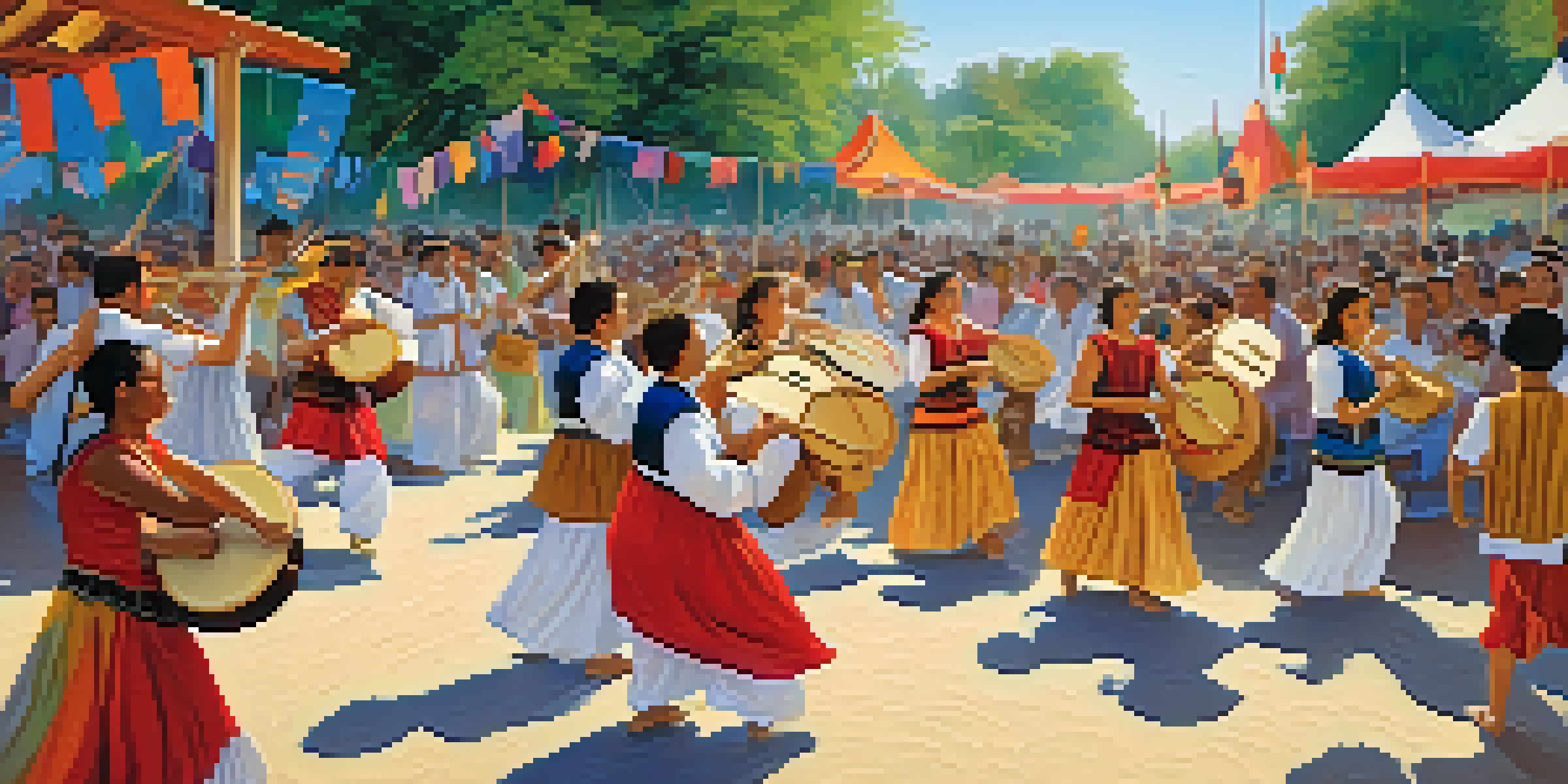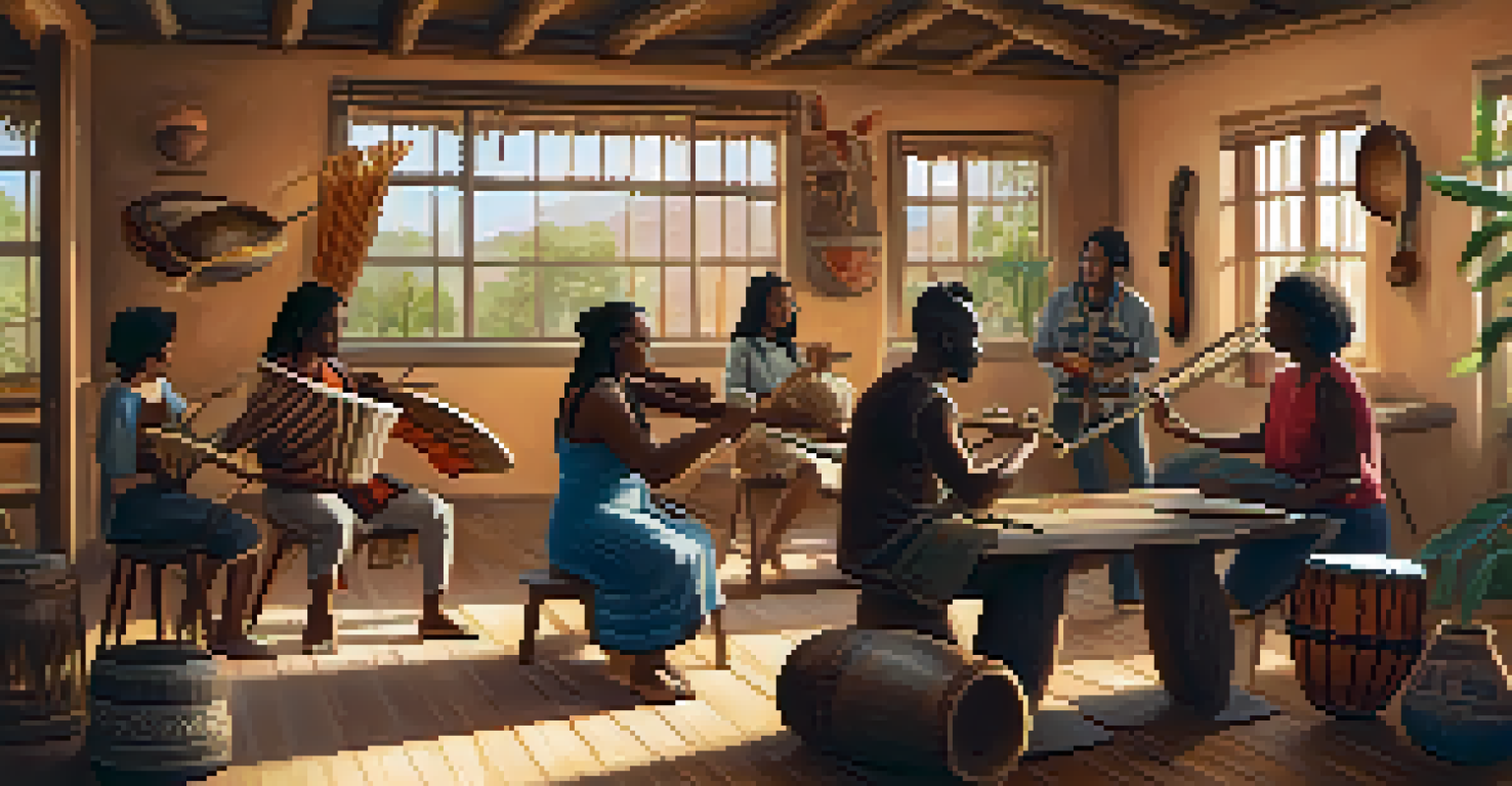Cultural Heritage and the Revival of Ancient Music Styles

Understanding Cultural Heritage and Its Importance
Cultural heritage encompasses the traditions, practices, and artifacts that a community passes down through generations. This heritage is crucial as it shapes our identity and connects us to our ancestors. When we explore cultural heritage, we often discover the rich tapestry of music that plays a significant role in storytelling and community bonding.
Music is the shorthand of emotion.
Different cultures have unique musical styles that reflect their values, beliefs, and histories. For instance, the rhythms of African drumming tell stories of struggle and triumph, while the melodies of traditional Irish music evoke a sense of home and belonging. By preserving these musical forms, we not only honor our past but also enrich our present.
The revival of ancient music styles is a way to sustain cultural heritage, ensuring that future generations can experience the sounds that have shaped their identities. This revival serves as a reminder of our shared humanity and the diverse expressions of life that music offers.
The Rise of Interest in Ancient Music Styles
In recent years, there has been a growing interest in ancient music styles, driven by a desire to connect with our roots. This resurgence is often fueled by social media and streaming platforms, where musicians can share their interpretations of traditional sounds with a global audience. It’s fascinating to see how modern technology is facilitating this revival.

Musicians worldwide are experimenting with ancient instruments and techniques, blending them with contemporary genres. For example, the fusion of traditional Middle Eastern instruments with modern electronic music has created a unique sound that appeals to younger listeners. This blend not only keeps ancient styles alive but also makes them relevant in today’s music scene.
Cultural Heritage Shapes Identity
Cultural heritage, including music, connects us to our roots and enriches our present experiences.
Events like folk festivals and cultural gatherings further promote this interest, allowing people to experience ancient music firsthand. Workshops and performances not only educate audiences but also encourage participation, fostering a sense of community around these timeless traditions.
Impact of Globalization on Ancient Music Styles
Globalization has had a profound impact on how ancient music styles are perceived and revived. On one hand, it has enabled the sharing of diverse musical forms across borders, allowing artists to collaborate and innovate. This cross-pollination of cultures can lead to exciting new genres but also raises questions about cultural appropriation.
The preservation of cultural heritage is the preservation of the soul of a community.
As ancient music styles gain popularity, it’s essential to approach their revival with respect and understanding. Many artists strive to honor the origins of these styles by collaborating with traditional musicians, ensuring that the roots of the music remain intact. This respectful exchange enhances the authenticity of modern interpretations.
However, the challenge lies in balancing tradition with innovation. While it’s important to keep ancient music styles alive, it’s equally crucial to adapt them in a way that resonates with contemporary audiences. Finding this balance is key to ensuring these musical forms continue to thrive.
Examples of Successful Revivals of Ancient Music
One remarkable example of reviving ancient music styles is the resurgence of traditional Native American music. Artists are not only preserving traditional songs but also incorporating them into modern genres like hip-hop and rock. This fusion has brought greater visibility to Native cultures and their musical heritage.
Another example can be found in the revival of the ancient Greek lyre. Modern musicians are exploring this ancient instrument, creating new compositions that draw on historical techniques while appealing to current musical tastes. The revival of such instruments showcases how ancient music can be reinterpreted for today’s audience.
Cultural Heritage Shapes Identity
Cultural heritage, including music, connects us to our roots and enhances our sense of belonging.
These successful revivals demonstrate that ancient music is not static; it evolves while maintaining its essence. By embracing these styles, artists contribute to a rich cultural dialogue that honors the past while looking toward the future.
The Role of Education in Reviving Ancient Music
Education plays a vital role in the revival of ancient music styles, as it fosters a deeper understanding of cultural heritage. Schools and universities are increasingly incorporating world music into their curricula, allowing students to explore diverse musical traditions. This exposure helps cultivate appreciation for ancient styles and their significance.
Workshops and community programs also offer hands-on experiences, teaching people how to play traditional instruments or sing ancient songs. These interactive opportunities help demystify ancient music and make it accessible to everyone, encouraging participation across generations. It’s about creating a shared space for learning and connection.
Moreover, the rise of online courses and digital resources has made it easier for anyone interested to delve into ancient music. With just a few clicks, individuals can access tutorials, videos, and articles that teach them about various styles and techniques. This democratization of knowledge is essential for sustaining the revival of ancient music.
Challenges in Preserving Ancient Music Styles
Despite the growing interest in ancient music, there are significant challenges in preserving these styles. One of the primary concerns is the loss of traditional knowledge, as fewer individuals possess the skills needed to perform ancient music. As elder generations pass away, so too does the expertise that has been handed down for centuries.
Additionally, commercialization can pose a threat to the authenticity of ancient music. As these styles gain popularity, there’s a risk that they may be altered or diluted to appeal to mainstream audiences. This can lead to a disconnect from their original cultural contexts, undermining the very essence of what makes them special.
Globalization Revives Ancient Music
The sharing of diverse musical forms through globalization encourages innovation while raising awareness about cultural appropriation.
To combat these challenges, community initiatives and cultural organizations are stepping up to document and preserve ancient music. By recording traditional performances and creating archives, they help ensure that these invaluable cultural treasures are not lost to time. It’s a collective effort that requires the participation of everyone invested in cultural heritage.
Looking Ahead: The Future of Ancient Music Styles
The future of ancient music styles looks promising, with continued interest and innovative approaches emerging. As artists blend traditional sounds with contemporary influences, we can expect to hear exciting new interpretations that resonate with diverse audiences. This ongoing evolution is a testament to the adaptability of ancient music.
Moreover, as global awareness increases regarding cultural preservation, there will likely be more support for initiatives aimed at keeping ancient music alive. This could include funding for cultural programs, grants for musicians, and collaborations between artists worldwide. Such efforts are essential for fostering a vibrant cultural landscape.

Ultimately, the revival of ancient music styles is not just about nostalgia; it’s about creating meaningful connections between past and present. As we navigate our fast-paced world, these timeless sounds remind us of our shared humanity and the rich stories that music can tell.